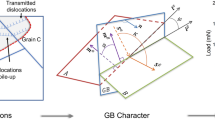Abstract
Various types of dislocation stoppers are identified and their basic parameters are determined. Using dislocation loops as an example, the effect of internal stresses on the motion of linear defects in n-and p-Si in the field of external elastic forces is estimated. It is found that preliminary magnetic treatment of silicon plates activates the dislocation transport. In the absence of external mechanical loads, displacement of dislocation half-loops (30–50 μm) in the nonuniform field of internal stresses in a silicon crystal with a scratch (stress concentrator) is detected experimentally during isothermal annealing for 0.5–3 h at a temperature of 600–700°C. Dislocation transport is described taking into account the intrinsic (lattice) potential barrier of the crystal and two types of stoppers on the basis of magnetosensitive point defects (dopant) and “forest” dislocations. A kinetic model is proposed for describing the magnetostimulated variation of the mobility of linear defects associated with the formation of long-lived complexes with a paramagnetic impurity. It is found experimentally that the velocity of dislocations in n-and p-Si increases by a factor of 2 and 3, respectively, upon treatment of the semiconductor in a magnetic field B=1 T for 5–45 min. The “magnetic memory” effect in silicon containing dislocations is detected and kinetic aspects of the effect under natural conditions of sample storage after the removal of the magnetic field are considered. Partial velocities of dislocations and their delay times at various types of stoppers are calculated from the matching of experiment with theory.
Similar content being viewed by others
References
V. I. Al’shits, E. V. Darinskaya, T. M. Perekalina, et al., Fiz. Tverd. Tela (Leningrad) 29, 467 (1987) [Sov. Phys. Solid State 29, 265 (1987)].
V. I. Al’shits, E. V. Darinskaya, and E. A. Petrzhik, Fiz. Tverd. Tela (Leningrad) 33, 3001 (1991) [Sov. Phys. Solid State 33, 1694 (1991)].
Yu. I. Golovin, R. B. Morgunov, and S. E. Zhulikov, Fiz. Tverd. Tela (St. Petersburg) 39, 495 (1997) [Phys. Solid State 39, 430 (1997)].
Yu. I. Golovin, R. B. Morgunov, V. E. Ivanov, et al., Pis’ma Zh. Éksp. Teor. Fiz. 68, 400 (1998) [JETP Lett. 68, 426 (1998)].
O. I. Datsko and V. I. Alekseenko, Fiz. Tverd. Tela (St. Petersburg) 39, 1234 (1997) [Phys. Solid State 39, 1094 (1997)].
E. V. Darinskaya, E. A. Petrzhik, S. A. Erofeeva, et al., Pis’ma Zh. Éksp. Teor. Fiz. 70, 298 (1999) [JETP Lett. 70, 309 (1999)].
V. I. Al’shits, E. V. Darinskaya, and E. A. Petrzhik, Fiz. Tverd. Tela (St. Petersburg) 24, 155 (1992) [Sov. Phys. Solid State 34, 81 (1992)].
V. A. Makara, L. P. Steblenko, N. Ya. Gorid’ko, et al., Fiz. Tverd. Tela (St. Petersburg) 43, 462 (2001) [Phys. Solid State 43, 480 (2001)].
A. A. Skvortsov, A. M. Orlov, V. A. Frolov, et al., Fiz. Tverd. Tela (St. Petersburg) 42, 1814 (2000) [Phys. Solid State 42, 1861 (2000)].
A. A. Skvortsov, A. M. Orlov, and L. I. Gonchar, Zh. Éksp. Teor. Fiz. 120, 134 (2001) [JETP 93, 117 (2001)].
M. I. Molotskii, Fiz. Tverd. Tela (Leningrad) 33, 3112 (1991) [Sov. Phys. Solid State 33, 1760 (1991)].
A. L. Buchachenko, R. Z. Sagdeev, and E. M. Salikhov, Magnetic and Spin Effects in Chemical Reactions (Nauka, Novosibirsk, 1978).
M. I. Molotskii, R. E. Kris, and V. Fleurov, Phys. Rev. B 51, 12531 (1995).
L. D. Landau and E. M. Lifshitz, Course of Theoretical Physics, Vol. 7: Theory of Elasticity, 3rd ed. (Nauka, Moscow, 1982; Pergamon, New York, 1986).
N. N. Novikov, Structure and Structure-Sensitive Properties of Real Crystals (Vishcha Shkola, Kiev, 1983).
M. P. Shaskol’skaya, Crystallography (Vysshaya Shkola, Moscow, 1984).
J. R. Patel, Phys. Rev. Lett. 33, 1436 (1966).
N. Ya. Gorid’ko, V. A. Makara, N. N. Novikov, and L. P. Steblenko, Fiz. Tverd. Tela (Leningrad) 31(5), 31 (1989) [Sov. Phys. Solid State 31, 738 (1989)].
V. A. Makara, L. P. Steblenko, V. V. Obukhovskii, et al., Fiz. Tverd. Tela (St. Petersburg) 42, 854 (2000) [Phys. Solid State 42, 877 (2000)].
G. A. Malygin, Fiz. Tverd. Tela (St. Petersburg) 42, 69 (2000) [Phys. Solid State 42, 72 (2000)].
T. Suzuki, H. Yosinaga, and S. Takeucti, Dislocation Dynamics and Plasticity (Syokabo, Tokyo, 1986; Mir, Moscow, 1989).
A. N. Orlov, Introduction to the Defect Theory in Crystals (Vysshaya Shkola, Moscow, 1983).
B. V. Petukhov, Izv. Akad. Nauk SSSR, Ser. Fiz. 51, 708 (1987).
J. Diehl, G. P. Seidel, and L. Niemann, Phys. Status Solidi 12, 405 (1965).
Author information
Authors and Affiliations
Additional information
__________
Translated from Zhurnal Éksperimental’no\(\overset{\lower0.5em\hbox{$\smash{\scriptscriptstyle\smile}$}}{l}\) i Teoretichesko\(\overset{\lower0.5em\hbox{$\smash{\scriptscriptstyle\smile}$}}{l}\) Fiziki, Vol. 123, No. 3, 2003, pp. 590–598.
Original Russian Text Copyright © 2003 by Orlov, Skvortsov, Solov’ev.
Rights and permissions
About this article
Cite this article
Orlov, A.M., Skvortsov, A.A. & Solov’ev, A.A. Behavior of dislocations in silicon in the presence of mechanical and magnetic perturbations. J. Exp. Theor. Phys. 96, 523–530 (2003). https://doi.org/10.1134/1.1567426
Received:
Issue Date:
DOI: https://doi.org/10.1134/1.1567426




